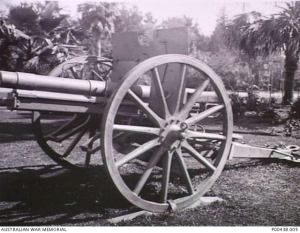In late 1916 the British Army fighting in Europe began to collect captured artillery pieces, mortars and guns for display as trophies of war and establish a war museum collection. In May 1917, at the urging of journalist and historian Charles Bean, Australia established the Australian War Records Section (AWRS) to collect for our own purposes. Over two years the AWRS collected over 25,000 objects as well as written records, manuscripts, maps and other war related material for a proposed war museum. The collection formed the basis of the Australian War Memorial.
While most of the material was destined for the proposed memorial, a selection was to be offered to all the States for distribution to local communities for display in parks and at schools. The distribution was to follow a set of guidelines put forward by State Trophy Committees. For towns, distribution depended on size of population: the more you had the bigger the trophy. If your town had more than 10,000 people you could get two artillery pieces and two machine guns, less than 3000 and only a machine gun was available.
Suburban Councils and Sydney schools were also allocated a trophy, although not everyone got one. Across NSW about 3000 were distributed, with close to 10,000 around Australia.

While it was expected that the trophies would be warmly accepted, the war had left deep wounds in some communities. The enormous loss of life and the trauma caused by the conscription debate had left many with a bitter taste and a real hostility to the glorification of the war.
In Sydney a number of Councils rejected the trophies. Redfern Council in the inner city was offered a German field gun in 1921 for mounting in Redfern Park. The Council rejected it, stating that the people had had enough of war and there was no need to display guns to impress upon them the active marks of war. The Council declared that instead of bothering about guns, the government should be helping those men who had returned and who needed their aid.
The local community was split, with a committee of citizens being formed to accept the gun in the suburbs behalf, in spite of the Councils stand. And so it was that Redfern got their gun, mounted opposite Redfern Park, as the Council refused to have it on council property. The Council was denounced as a pack of Sinn Fein supporters (a hint at growing sectarianism in Australia), disloyal to Australia and Empire. In 1922 the gun was pushed from its pedestal by unknown persons.
Sydney City Council also refused to allow war trophies to be displayed in the city. Although they had taken the Emden Gun in 1917, by 1920 the mood had changed and no more were wanted. Willoughby Council was also torn over the issue. As with Redfern, councillors called on the mayor to reject the offer and to help the returned veterans instead. One councillor called it rank hypocrisy to accept a trophy when men were in need. Memorials were one thing, but garish prizes quite another.

But even for those who accepted them there was still tension. Auburn, who received a trench mortar felt hard done by, believing their efforts in the war deserved more recognition, particularly since Parramatta had got such a big gun.
Gun envy was a common complaint where the size of the weapon became synonymous with civic pride and what they did in the war.
But where are they now? Almost 80% of the guns allocated have disappeared, scrapped, put in storage, sold or simply lost. Ironically those remaining represent one of (if not) the best collection of WW1 German artillery pieces in the world and has become a significant heritage and military technology collection.
If you want to follow this further, here is a full thesis on the topic.